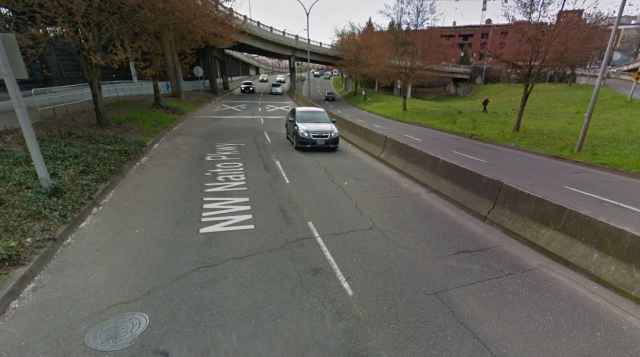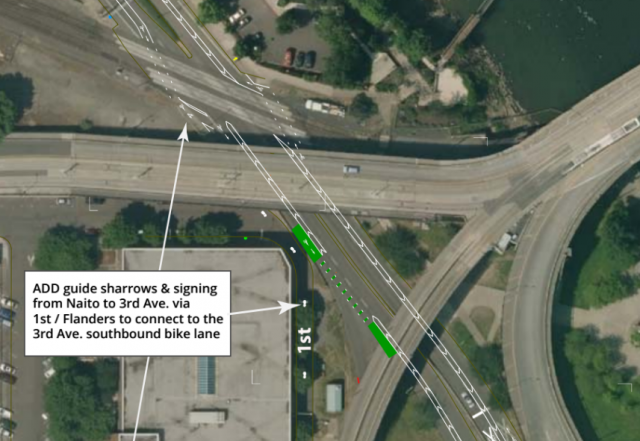
(Image: Google Street View)
After nine years of sometimes elaborate plans to connect NW Naito Parkway’s bike lanes north and south of the Steel Bridge, the city’s transportation bureau has found a way.
The secret: it’s removing an unnecessary passing lane in each direction between NW Davis and NW Ironside Terrace to create continuous bike lanes that will be, at their widest, 10 feet with a four-foot buffer.
In the northbound direction, this will mean converting the rightmost auto lane of Naito into a right-turn-only lane leading to the Steel Bridge:
“In the northbound direction, half the traffic is exiting Naito onto the Steel Bridge,” the city wrote in a memo circulated to northwest Portlanders Wednesday. “The provision of a right turn only lane will facilitate this. In the southbound direction, Naito is already one lane north of Ironside Terrace; with adjustments to the traffic signal timing at Everett, Davis and Couch the traffic should flow well.”
This is basically the same trick that the Oregon Department of Transportation realized it could use to close a different notorious bike lane gap on Southwest Barbur Boulevard. (By the way, stay tuned: we’ve been in correspondence with ODOT for weeks to get an update on that project.)
It’s happening now because the city just repaved the pockmarked pavement between NW Davis and 9th, which in its words “provided a ‘clean slate’ to restripe the roadway.”
The city says the redesign will have the added benefit of reducing excessive speeding here, presumably because the single lane will remove the temptation for anxious people to weave around other cars freeway-style in order to get to wait one or two spaces ahead at the next red light.
Though this stretch of Naito has a 30 mph speed limit, the “85th percentile speed” here is 38 mph southbound and 36 mph northbound. This is a standard way of measuring typical traffic speeds that means 15 percent of autos are moving faster than 38/36 mph.
Advertisement
Closing the so-called “Naito Gap” was identified as a priority in the city’s 2010 bike plan and last year’s West Quadrant Plan. Northwest of this area, Naito and 9th sees an estimated 1,600 bike trips daily, a number that seems likely to increase with this new direct connection to the central city.
Here are some more details from the new cross-section, proceeding north:
And over the crucial railroad crossing, where the roadway narrows beneath the Steel Bridge. This is the site that has given the city so much grief as it has tried to get bike lanes to cross the tracks at safely obtuse angles, a difficult trick when there was minimal road space to play with:
and finally north of the Steel Bridge overpasses:
Converting the unnecessary passing lanes to wide bike lanes (which the city also did last year on NE 15th/16th in the Lloyd District, with no apparent ill effects) will also greatly improve the safety and comfort of walking across this part of Naito, because there’ll be no more “double threat” when a stopped car in one lane creates a blind spot for the second lane in the same direction. This is one of the major sources of death and injury for people walking.
It’s a major step toward reducing car dependence in northwest Portland.
There’s one possible tradeoff here: when a train is going through, Naito will have less room to store cars, which could cause a queue running south on Naito. But there’s only one significant crossing of Naito that might be blocked — the Steel Bridge onramp at Davis — and it shouldn’t be hard for people to keep their waiting cars far enough apart to keep that clear for people heading over the bridge. It’s notable that Union Pacific Railroad and the ODOT’s rail division have apparently signed off on this plan.
The queue will also actually have an upside for people driving: people planning to use Naito will get advance warning when the train is blocking their path in time to take a detour.
All in all, this looks like fantastic news for closing a gap we’ve been reporting on since Naito first got bike lanes in 2007. In the years since, the riverside north of the Steel Bridge and the north Pearl District further northwest have added thousands of new homes, all of which will now get a dramatically more comfortable biking option into downtown, the central east side and beyond.
This also sets up a greatly improved connection to Naito for the future Flanders Neighborhood Greenway, which will be made possible by the new Flanders Crossing Bridge that seems likely to be funded by the Oregon Department of Transportation’s Connect Oregon program. That bridge would be due to open in 2019, creating the first modern, low-traffic bikeway between the Northwest District and the city’s riverside network of bike paths.
In other words, it’s a major step toward reducing car dependence in northwest Portland. And it’s supposed to happen in a matter of days — in time for northwest Portland to become one of North America’s best places to get around by bike sharing.
“A work order has been issued but we don’t have an exact date yet for when this will be done,” city spokeswoman Hannah Schafer said in an email Wednesday. “Rainy weather the next few days will likely slow down any striping projects.”
— Michael Andersen, (503) 333-7824 – michael@bikeportland.org
Our work is supported by subscribers. Please become one today.





